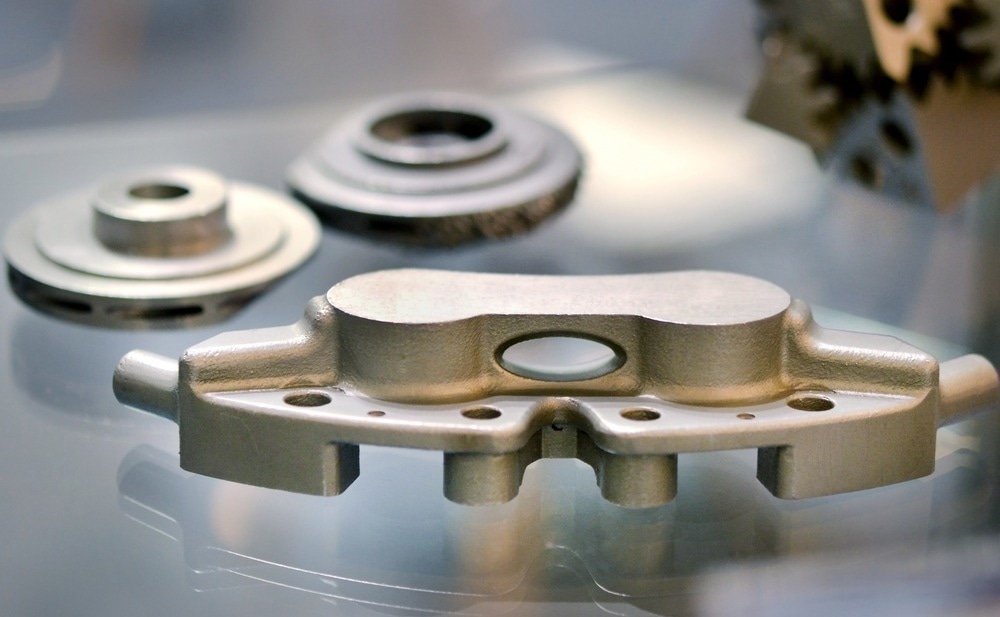 By Surbhi JainReviewed by Susha Cheriyedath, M.Sc.Aug 5 2022
By Surbhi JainReviewed by Susha Cheriyedath, M.Sc.Aug 5 2022In an article recently published in the journal Additive Manufacturing, researchers discussed the utility of phase transformation dynamics in the development of alloys for additive manufacturing (AM).

Study: Phase transformation dynamics guided alloy development for additive manufacturing. Image Credit: MarinaGrigorivna/Shutterstock.com
Background
Fusion-based AM, such as directed energy deposition and laser powder bed fusion, combines the production of materials and parts in a single process. By enabling the customized creation of geometrically and aesthetically complex parts with previously unheard-of functionality and performance, it has the potential to completely transform the industrial sector. For materials exhibiting multi-stage phase change during AM fabrication, the complicated and frequently harsh temperature conditions of AM, inherent to a confined heat source-material interaction, provide significant hurdles to consistently attaining required phases in the as-printed parts.
Precipitation-hardening (PH) martensitic stainless steel 17-4 is one well-known instance. There have been significant phase control difficulties in the creation of AM 17-4 steel. While the main source of strength in conventional 17-4 is martensite, AM 17-4 can also have a sizeable amount of residual austenite and even a sizeable portion of δ-ferrite in its as-built form. Therefore, it is crucial to comprehend the sequence of nonequilibrium phases that 17-4 steel undergoes during AM processing and to create an alloy within the 17-4 composition window that can consistently supply the desirable performance attributes of 17-4 in its as-prepared state.
About the Study
In this study, the authors discussed the phase transformation dynamics-guided growth of martensite stainless steel that was discovered using in situ high-energy, high-speed, high-resolution X-ray diffraction. Direct printing of parts with a fully martensitic structure was possible owing to the stainless steel that was developed with the consistent formation of the requisite fully martensitic structure throughout a wide range of cooling speeds in the range of 102-107 °C/s. The yield strength of the printed material, 1157 ± 23 MPa, was comparable to that of its wrought counterpart following precipitation-hardening heat treatment.
The team credited the totally martensitic structure and the fine precipitates created during the intrinsic heat treatment in additive manufacturing with the as-printed characteristic. The development of dependable, high-performance alloys tailored for additive manufacturing was possible thanks to the phase transition dynamics-guided alloy development technique that was demonstrated in this study.
The researchers illustrated the formation of a fully martensitic microstructure in a 17-4 PH martensitic stainless steel over a wide range of cooling rates, guided by the phase transformation dynamics. In contrast to the typical strategy, which mainly focused on the solid-solid phase transition, the results of the phase transformation dynamics directed the alloy development to concentrate on the transformation of the liquid-solid phase during early solidification. The developed alloy exhibited excellent tolerance to variations in cooling rate. In order to create strengthening precipitates in its printed state, it also made use of the inherent heat treatment inherent in AM processing. The prepared alloy had good mechanical properties due to its entirely martensitic structure and fine precipitates.
Observations
The yield strength of the as-printed UW 17-4 was 1157 ± 23 MPa, which was more than 40% greater than that of the as-printed C_17-4 at 811 ± 16 MPa. Casting or arc melting, laser spot welding, and single-layer laser melting were all used to achieve three cooling speeds, on the orders of 102 °C/s, 107 °C/s, and 104 °C/s, respectively. Under a cooling rate of 1.7 x 104 °C/s, the developed UW 17-4 could successfully construct a completely martensitic structure. Only 76 mass.% of residual δ-ferrite, 17 mass.% of the required martensite, and 7 mass.% of residual austenite made up the final phase constitution in laser-melted C_17-4.
The phase transformation dynamics of 17-4 PH stainless steel during rapid solidification focused on the early liquid-solid phase change during solidification. In order to reach the desired totally martensitic phase in the final structure of the UW_ 17-4, the proposed alloy development technique boosted the austenite-to-martensite transformation while minimizing the creation of the first δ-ferrite phase. It was shown that the created alloy could survive common environmental contaminants and preserve a fully martensitic structure in the as-solidified condition under a vast range of cooling rates.
Regardless of variations among AM machines, printing regions, and printing batches, the material's tolerance to the diverse thermal and chemical conditions was essential for industrial adoption to provide dependable and consistent additively manufactured parts. The as-printed additively manufactured parts' ability to produce appropriate phases in a single step could eliminate the need for the pricey and complex post-heat treatment necessary for phase adjustment, and could thus increase production efficiency and lower time, energy, and labor costs.
Conclusions
In conclusion, this study created a strong martensitic 17-4 stainless steel (UW 17-4) for additive manufacturing using phase transition dynamics as a guide. The alloy development technique described in this study highlighted how crucial it is to comprehend phase change dynamics in AM settings.
For the additive manufacturing sector, the authors anticipate that phase transition dynamics-guided alloy development will result in the creation of more durable, high-performance materials.
More from AZoM: ICP-MS for Trace Metal Analysis
Disclaimer: The views expressed here are those of the author expressed in their private capacity and do not necessarily represent the views of AZoM.com Limited T/A AZoNetwork the owner and operator of this website. This disclaimer forms part of the Terms and conditions of use of this website.
Sources:
Guo, Q., Qu, M., Chuang, C. A., et al. Phase transformation dynamics guided alloy development for additive manufacturing. Additive Manufacturing 103068 (2022).
https://www.sciencedirect.com/science/article/abs/pii/S2214860422004602